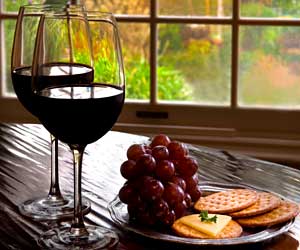Great ingredients make for great meals. Whenever you can, use the highest quality supplies for your recipes. The flavor difference will always come through in your finished dish.
If there is an ingredient that you are not familiar with, check our Ingredient section. There are pages and pages of information about the ingredients used in my recipes.

Ingredient Information
Wine in Recipes
There are three reasons to use wine in recipes. One is as a marinade where the acidity aides in tenderizing meats and other ingredients. The second is as a cooking liquid. Either way, the main reason is that wine adds flavor to your dish. Vinegar or lime juice help tenderize but too much of them will overwhelm a dish. Wine, on the other hand, will enhance your recipe and complement but not overwhelm other flavors.
Choosing the Right Wine for Your Recipe
Usually the instructions are not specific and simply call for white wine or red wine. You may not think much about this but like every other ingredient the choice of wine can have a major effect on the final flavors in your dish. For example, a full bodied cabernet can easily overwhelm a dish that you intended to be more subtle.
Cooking with the best quality ingredients results in the best quality dish and this applies with your choice of wine. That doesn't mean that you have to spend 30 dollars on a bottle of wine, however. It is unlikely that you will get that much more bang for your buck from high priced wine but you shouldn't spend 2 dollars on wine for your recipes. If the wine tastes bad, your final dish will also.
The first rule of thumb for which wine to use lies with the type of recipe you are cooking. If it is a sweet, delicate dish, choose a sweeter wine like a Riesling. If the meal is a robust stew that calls for red wine, a full bodied selection like cabernet or zinfandel will work. The table below is a guideline to help you:
| Style of Dish | Choose This Wine |
Sweeter |
Riesling, Viognier, Gewurztraminer |
Very Sweet |
Port, Sherry, Madeira |
Tart, Acidic |
Sauvignon Blanc, Fume Blanc |
Creamy |
Chardonnay |
Robust Savory (reds) |
Cabernet, Zinfandel, Bordeaux |
Light Savory (reds) |
Pinot Noir, Burgundy |
Light Savory (whites) |
Chardonnay |
The second (and easy) rule of thumb is to choose the wine for your recipe by simply using the wine you will drink with the dish. Simple.
What Happens to the Alcohol in Wine?
As you cook with wine, the water evaporates, the volume reduces and the flavors concentrate. Most of the recipes you follow will tell you how much wine to add. If you are adding wine without that instruction, no more than about 1/4 cup of wine per serving is a good guide. It is also a good idea to add the wine early not only to concentrate flavors but also to allow as much of the alcohol to evaporate as possible.
This is because most of the alcohol evaporates but not completely. There isn't much alcohol in wine with less than a half-teaspoon of alcohol in a tablespoon of wine. Alcohol evaporates faster than the water in the wine, but there will still be a little alcohol left after cooking and the less there is the less harsh tasting the final dish.
Using Cooking Wine
Don't purchase cooking wine. While it is no longer widely available, cooking wine has a harsh taste due to a higher alcohol content. It also contains salt.
